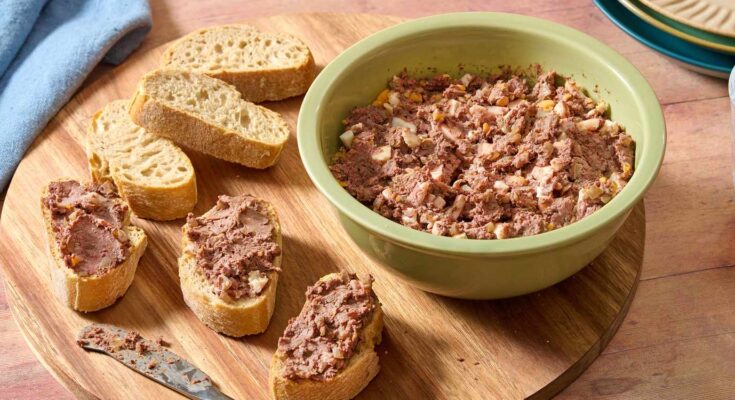Chopped Liver Recipe: Chopped liver might not sound glamorous, but for anyone who’s had a taste of this classic dish, you know it’s way more delicious than the name suggests. Whether served as a party spread, holiday appetizer, or a comforting snack between two slices of rye bread, chopped liver holds a special place in many households—especially in Jewish cuisine.
It’s rich, savory, and bursting with deep umami flavor that gets better the longer it sits. This isn’t your average liver dish—when made right, chopped liver is a velvety, flavorful spread that’s unforgettable.
In this guide, we’re going to walk you through everything—from the ingredients to the final serve—so you can make a batch that’s just like grandma’s (or maybe even better).
The History Behind Chopped Liver
Chopped liver has deep roots in Ashkenazi Jewish tradition, originally brought to America by immigrants from Eastern Europe. It was a practical dish—liver was affordable and nutritious, and nothing went to waste. Paired with rendered chicken fat (schmaltz) and caramelized onions, it turned into something surprisingly luxurious.
In Jewish homes, chopped liver made frequent appearances during Shabbat dinners and holiday feasts like Passover and Rosh Hashanah. Over time, it found its way into delis across New York City and beyond, becoming a nostalgic favorite for many.
You’ll often hear people joke, “What am I, chopped liver?”—a phrase that actually stems from the dish being overlooked on a table full of flashier entrees. But trust me, one bite of this spread, and you’ll never overlook it again.
Why You’ll Love This Recipe
Let’s be real: liver doesn’t always get a good rep. But this chopped liver recipe will absolutely change your mind. Why? Because it’s:
- Creamy and rich with layers of flavor
- Savory and satisfying, thanks to the slow-cooked onions and schmaltz
- Versatile—use it as a spread, stuffing, or even a dip
- Nutrient-dense, especially high in iron, B vitamins, and protein
Plus, this version is incredibly easy to make. You only need a handful of ingredients, and the process is straightforward once you know what to look for. Whether you’re revisiting childhood flavors or trying something new, this is comfort food with character.
List of Ingredients You’ll Need
Here’s what you’ll need to gather before we get started:
- 1 pound fresh chicken livers (cleaned and trimmed)
- 3 large yellow onions, finely sliced
- 3 hard-boiled eggs
- 4 tablespoons schmaltz (or substitute with vegetable oil or butter)
- Salt (about 1 tsp, or to taste)
- Freshly ground black pepper (about ½ tsp, or to taste)
- Optional: garlic, parsley, a splash of brandy, or a pinch of nutmeg for extra flavor
This recipe is traditional at its core, but it’s also super flexible. Don’t have schmaltz? You can use olive oil or butter. Want more texture? Use a knife instead of a food processor. We’ll break it all down below.
Choosing the Best Chicken Livers
Not all livers are created equal. Freshness is key here, so try to source chicken livers from a local butcher or a store with high turnover. Here’s what to keep in mind:
- Color: They should be deep reddish-brown with a glossy surface
- Texture: Smooth and firm, not mushy or slimy
- Smell: Mild, slightly sweet; never sour or metallic
Cleaning the livers is a crucial step. Trim off any connective tissue or green spots (from the gallbladder), as they can impart a bitter taste. Rinse under cold water and pat dry before cooking. This will help them sear better and avoid a grainy texture.
The Role of Schmaltz in Chopped Liver
If chopped liver had a secret weapon, it would be schmaltz. Schmaltz is rendered chicken fat—liquid gold in Jewish cooking—and it’s what gives chopped liver that unmistakable richness.
To make your own schmaltz:
- Save chicken skin and fat trimmings
- Cook them slowly in a pan until all the fat renders out
- Strain and store
No schmaltz? No problem. You can substitute with:
- Vegetable oil for a neutral flavor
- Butter for a creamy, slightly sweet finish
- Duck fat for an upscale twist
But if you want the most authentic flavor, schmaltz is the way to go.
Preparing the Onions
Here’s where the magic starts. Onions are not just a supporting character in chopped liver—they’re the flavor backbone. Slowly sautéing them brings out their natural sweetness and balances the strong flavor of the liver.
How to get perfect caramelized onions:
- Use low to medium heat
- Stir often to avoid burning
- Cook for at least 25-30 minutes
- Aim for a golden brown, not blackened color
Pro tip: Don’t rush the onions. The deeper the caramelization, the richer the final dish.
Boiling the Eggs
Hard-boiled eggs add creaminess and structure to chopped liver. Here’s how to get them just right:
Steps for perfect hard-boiled eggs:
- Place eggs in a pot and cover with cold water
- Bring to a gentle boil
- Boil for 9–10 minutes
- Immediately transfer to an ice bath
Once cool, peel and set aside. You’ll mash or process them into the mix later for that signature creamy texture.
Step-by-Step Guide to Making Chopped Liver
Now that we’ve prepped everything, let’s put it all together.
Step 1: Prep the livers
Clean, rinse, and pat dry the livers. Trim off any membranes or greenish spots.
Step 2: Cook the onions
In a large skillet, heat 2 tablespoons of schmaltz. Add the onions and cook low and slow until deeply caramelized (about 25–30 minutes). Remove and set aside.
Step 3: Cook the livers
Add another tablespoon of schmaltz to the same pan. Add the livers and sauté until browned on the outside but still slightly pink inside—about 5–7 minutes. Overcooking will make them grainy.
Step 4: Combine ingredients
In a bowl or food processor, combine livers, onions, chopped eggs, remaining schmaltz, salt, and pepper.
Step 5: Chop or blend
Pulse until you reach your preferred texture—some like it smooth, others chunky. For a traditional feel, hand-chop with a mezzaluna or knife.
Let cool and refrigerate for at least 2 hours before serving for best flavor.
Should You Use a Food Processor or Hand Chop?
Here’s a question that divides households and generations alike: do you go modern and use a food processor, or keep it old-school with a knife and cutting board?
Food Processor Method:
- Pros: Quick, consistent, and less messy. It’s perfect if you’re short on time or making a large batch.
- Cons: Can over-process if you’re not careful, resulting in a paste-like texture. You might lose some of the hearty, rustic charm that chopped liver is known for.
Hand-Chopped Method:
- Pros: Traditional and time-honored. Chopping by hand gives you full control over texture—perfect if you like it coarse with a bit of bite.
- Cons: Takes more time and effort. Be prepared for some elbow grease.
Personal tip? Try a hybrid. Lightly pulse half the mixture in a food processor and hand-chop the rest, then combine. You get the best of both worlds—creamy with a touch of texture.
Seasoning to Taste
Here’s where your chopped liver truly becomes your own. Seasoning is everything. Even with the right ingredients and texture, it won’t shine without salt, pepper, and maybe a few flavor enhancers.
Basic Seasoning Tips:
- Start with 1 tsp kosher salt and ½ tsp black pepper
- Taste, adjust, and repeat until it hits that perfect balance
- Let it chill for a few hours, then taste again before serving—it gets better as flavors meld
Optional Add-ins:
- A pinch of garlic powder or fresh garlic for extra kick
- Paprika for color and warmth
- Parsley or chives for freshness
- A splash of brandy or sherry for depth (use sparingly)
The goal is balance. Liver has a strong flavor, and the eggs and onions mellow it out. Seasoning should highlight, not overpower.
How to Serve Chopped Liver
Chopped liver is versatile, and how you serve it really depends on the occasion. Whether it’s a holiday table or a casual brunch, here are some classic and creative serving ideas:
Traditional Ways:
- Spread on matzo during Passover
- Served in a bowl with a sprig of parsley and sliced hard-boiled egg on top
- As a side dish alongside gefilte fish or brisket
Modern Ideas:
- On crostini or crackers as a party appetizer
- In a sandwich with pickles and mustard on rye bread
- As a filling in lettuce cups for a low-carb option
For presentation, go simple: smooth out the top, drizzle with a bit of schmaltz or olive oil, garnish with fresh herbs or sliced egg. It’s humble, but when plated with care, it can be surprisingly elegant.
Storing and Making Ahead
One of the best things about chopped liver? It stores beautifully and actually tastes better the next day.
Refrigerator Storage:
- Store in an airtight container
- Lasts up to 5 days
- The flavors deepen over time, so it’s ideal for making ahead
Freezing:
- Yes, you can freeze chopped liver, but it may slightly affect the texture
- Freeze in small portions using airtight containers or freezer bags
- Thaw overnight in the fridge, stir well before serving
Pro tip: If you’re making it for a holiday meal, prepare it 1–2 days ahead to save time and allow flavors to develop.
Common Mistakes to Avoid
Even with a simple recipe, a few small missteps can ruin the texture or flavor of chopped liver. Let’s make sure that doesn’t happen to you.
1. Overcooking the Livers
Liver should be just pink inside when you finish cooking. If you overcook, it turns tough and grainy. Think of it like a steak—medium is perfect.
2. Rushing the Onions
Caramelizing onions is not a 5-minute task. If you sauté them too quickly on high heat, you’ll burn them. Go low and slow for that sweet, golden flavor.
3. Not Seasoning Enough
Remember, liver has a bold flavor that needs balancing. Always taste and adjust the seasoning. Don’t just rely on the salt in your schmaltz or onions.
4. Skipping the Chill Time
Freshly made chopped liver is good—but after a few hours (or overnight), it’s amazing. Don’t skip the resting phase in the fridge. It’s worth the wait.
Variations of Chopped Liver
While traditional chopped liver is all about chicken livers, onions, eggs, and schmaltz, there are a few fun and creative ways to put a spin on the classic.
Vegetarian or Vegan Options:
- Mock chopped liver made with lentils, mushrooms, walnuts, and sautéed onions
- Use olive oil or vegan butter instead of schmaltz
- Add umami with soy sauce or miso
Add-Ins for Flavor Enhancements:
- Roasted garlic for mellow depth
- Diced apples or dates for a hint of sweetness
- Crispy shallots or fried onions for texture on top
Chopped liver doesn’t have to be boring—it can be whatever you want it to be. Just keep that balance of richness, creaminess, and a little bite.
Nutritional Information
Chopped liver isn’t exactly diet food—but it is nutrient-dense. It provides essential vitamins and minerals, especially when made traditionally.
| Nutrient | Per 2 oz serving |
|---|---|
| Calories | ~180 kcal |
| Protein | ~9g |
| Total Fat | ~14g |
| Saturated Fat | ~4g |
| Cholesterol | High (~180mg) |
| Iron | ~30% DV |
| Vitamin A | ~80% DV |
| Vitamin B12 | ~100% DV |
Note: If you’re watching your cholesterol, enjoy chopped liver in moderation. But if you need a boost of iron or B12, this is one tasty way to get it.
Pairing Ideas: What Goes Well with Chopped Liver
Want to make a full spread around your chopped liver? Here’s what works beautifully on the same plate or table:
Best Breads & Crackers:
- Rye bread
- Matzo
- Pita chips
- Seeded crackers
Perfect Accompaniments:
- Pickled vegetables (cucumbers, beets, onions)
- Horseradish or mustard
- A light salad with lemon vinaigrette
- Boiled or roasted potatoes
Drink Pairings:
- Dry white wine (Sauvignon Blanc, Chardonnay)
- A light beer or lager
- Sparkling water with lemon for a refreshing contrast
The richness of chopped liver is best balanced with acidity and crunch—so think pickles, vinegar-based salads, or something with a bit of zip.
FAQs about Chopped Liver Recipe
1. Can I make chopped liver without eggs?
Yes, you can! Eggs add creaminess and body, but if you’re out of them or avoiding them, just increase the onions and blend slightly longer for a smoother texture.
2. Is chopped liver kosher?
Yes, when prepared with kosher ingredients (chicken livers, schmaltz, eggs) and proper handling, it’s considered kosher. Just make sure it’s not mixed with dairy.
3. Can I use beef liver instead of chicken liver?
You can, but the flavor is much stronger. If using beef liver, soak it in milk or saltwater for 1–2 hours to mellow the taste, and slice it thinner before cooking.
4. How long does chopped liver last in the fridge?
It lasts up to 5 days when stored in an airtight container. For best flavor, consume within 2–3 days.
5. Can I freeze chopped liver?
Yes, though the texture may change slightly. Freeze in small portions and thaw slowly in the fridge. Stir before serving.
Conclusion
Chopped liver is more than just a spread—it’s a comfort food classic steeped in tradition, flavor, and family memories. Whether you grew up with it or are trying it for the first time, this recipe brings all the heart, richness, and nostalgia in every bite.
Take your time with the steps, taste as you go, and don’t forget to let it chill before digging in. Serve it proudly on your next holiday table or as a surprising appetizer for guests—it’s the kind of dish that always starts a conversation.
Homemade chopped liver is bold, beautiful, and absolutely worth the effort. So go ahead, give it a try. You might just find your new favorite spread.



